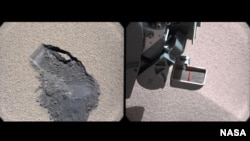NASA's Curiosity rover has sampled Martian rocks and soil, analyzing them using instruments inside the roving laboratory.
Curiosity has scooped up and studied its first gulp of Martian soil, and mission scientists say there is still no conclusive evidence of Martian organics from these early experiments.
Mission scientists did not seem disappointed when they spoke to reporters at the American Geophysical Union meeting in San Francisco, California Monday, saying they were not expecting to find proof of Martian building blocks of life at this stage of the mission.
Curiosity did find interesting ingredients in what one mission scientist called "typical ordinary Martian soil." The rover's instruments detected sulfur and chlorine-containing substances, and also found water molecules. But NASA says this is not unusual and does not mean that the area is wet.
John Grotzinger, the Mars Science Laboratory project scientist, says the rover's Sample Analysis at Mars instrument is working well.
"It [Curiosity's Sample Analysis at Mars instrument] has made this detection of organic compounds, simple organic compounds. We just simply don't know if they're indigenous to Mars or not," said Grotzinger.
Researchers caution that Curiosity's highly sensitive instruments could have picked up on residual organic compounds from Earth that are still in Curiosity's system.
Project scientist Grotzinger says it will take time to rule out that possibility and to further analyze soil samples. He adds that "Curiosity's middle name is patience."
The car-sized rover is four months into its mission, exploring near the foot of a peak called Mount Sharp within a deep, 150-kilometer-wide depression called Gale Crater.
The overall goal of NASA's $2.5 billion Mars Science Laboratory mission is to use Curiosity's 10 scientific instruments to learn if Mars ever offered a habitable environment for micro-organisms.
Curiosity has scooped up and studied its first gulp of Martian soil, and mission scientists say there is still no conclusive evidence of Martian organics from these early experiments.
Mission scientists did not seem disappointed when they spoke to reporters at the American Geophysical Union meeting in San Francisco, California Monday, saying they were not expecting to find proof of Martian building blocks of life at this stage of the mission.
Curiosity did find interesting ingredients in what one mission scientist called "typical ordinary Martian soil." The rover's instruments detected sulfur and chlorine-containing substances, and also found water molecules. But NASA says this is not unusual and does not mean that the area is wet.
John Grotzinger, the Mars Science Laboratory project scientist, says the rover's Sample Analysis at Mars instrument is working well.
"It [Curiosity's Sample Analysis at Mars instrument] has made this detection of organic compounds, simple organic compounds. We just simply don't know if they're indigenous to Mars or not," said Grotzinger.
Researchers caution that Curiosity's highly sensitive instruments could have picked up on residual organic compounds from Earth that are still in Curiosity's system.
Project scientist Grotzinger says it will take time to rule out that possibility and to further analyze soil samples. He adds that "Curiosity's middle name is patience."
The car-sized rover is four months into its mission, exploring near the foot of a peak called Mount Sharp within a deep, 150-kilometer-wide depression called Gale Crater.
The overall goal of NASA's $2.5 billion Mars Science Laboratory mission is to use Curiosity's 10 scientific instruments to learn if Mars ever offered a habitable environment for micro-organisms.







